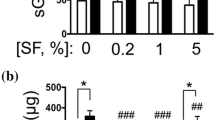Abstract
Human monocyte IL-1 stimulated the release of proteoglycans from cartilage in organ culture in a concentration-related manner. This stimulation required protein synthesis as shown by inhibition with cycloheximide. The metal chelator, 1,10-phenanthroline, inhibited breakdown, suggesting the involvement of a metalloproteinase. Various nonsteroidal anti-inflammatory drugs (100 μM), and the corticosteroids, dexamethasone and hydrocortisone (1–10 μM), were not effective in blocking proteoglycan release. Of the disease modifying agents tested, levamisole was ineffective while the antimalarials, chloroquine (100 μM) and hydroxychloroquine (100 μM), inhibited the action of IL-1. The free- radical inhibitor SOD (5000 U/ml but not 1000 U/ml) was effective while catalase (8000 U/ml) was not. The protective effects of SOD and the antimalarials suggest that oxygen reactive species may play a role, while lack of inhibition with NSAIDs and corticosteroids indicate that arachidonic acid metabolites may not be important in this degradative process.
Similar content being viewed by others
References
W. R. Benjamin, P. T. Lomedico and P. L. Killian,Interleukin-1. InAnnual Reports in Medicinal Chemistry. pp. 173–183. (Ed. D. M. Bailey) Academic Press, Inc. (1985).
D. D. Wood, E. J. Ihrie, C. A. Dinarello and P. L. Cohen,Isolation of an interleukin-1-like factor from human joint effusions. Arthritis Rheum.26, 975–983 (1983).
E. Mochan, J. Uhl and R. C. Newton,Interleukin-1 stimulation of synovial cell plasminogen activator production. J. Rheum.13, 15–19 (1986).
R. W. Farndale, C. A. Sayers and A. J. Barrett,A direct spectrophotometric microassay for sulfated glycosaminoglycans in cartilage cultures. Conn. Tiss. Res.9, 247–248 (1982).
H. Sheppeard, L. M. C. Pillsworth, B. Hazleman and J. T. Dingle,Effects of antirheumatic drugs on the production and action of porcine catabolin. Ann. Rheum. Dis.41, 463–468 (1982).
K. D. Rainsford,Effects of anti-inflammatory drugs on catabolin-induced cartilage destruction in vitro. Int. J. Tiss. Reac. VII(2): 123–126 (1985).
H. Burkhardt, M. Schwingel, H. Menninger, H. W. Macartney and H. Tschesche,Oxygen radicals as effectors of cartilage destruction. Arthritis Rheum.29(3), 379–387 (1986).
M. Gowen, D. D. Wood, E. J. Ihrie, J. E. Meats and R. G. G. Russell,Stimulation by human interleukin-1 of cartilage breakdown and production of collagenase and proteoglycanase by human chondrocytes but not human osteoblasts in vitro. Biochim. Biophys. Acta797, 186–193 (1984).
Y. Miyacki, A. Yoshioka, S. Imamura and Y. Niwa,Antioxidant action of antimalarials. Ann. Rheum. Dis.45, 244–248 (1986).
S. J. Duncan and J. J. Reynolds,The effects of Razoxane (ICRF 159) on the production of collagenase and inhibitor (TIMP) by stimulated rabbit articular chondrocytes. Biochem. Pharmac.32 (24), 3853–3858 (1983).
Author information
Authors and Affiliations
Rights and permissions
About this article
Cite this article
Arner, E.C., Darnell, L.R., Pratta, M.A. et al. Effect of antiinflammatory drugs on human interleukin-1-induced cartilage degradation. Agents and Actions 21, 334–336 (1987). https://doi.org/10.1007/BF01966508
Issue Date:
DOI: https://doi.org/10.1007/BF01966508




